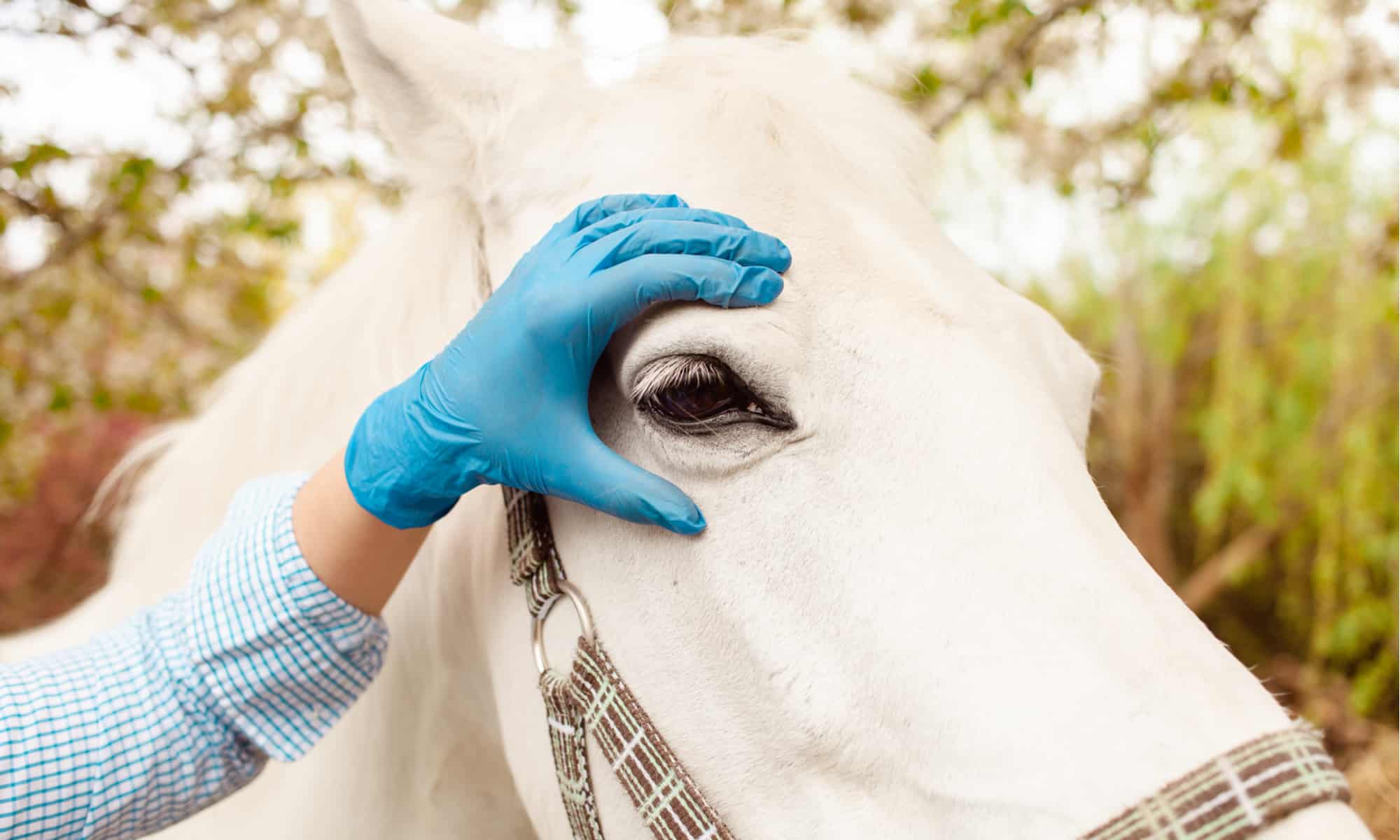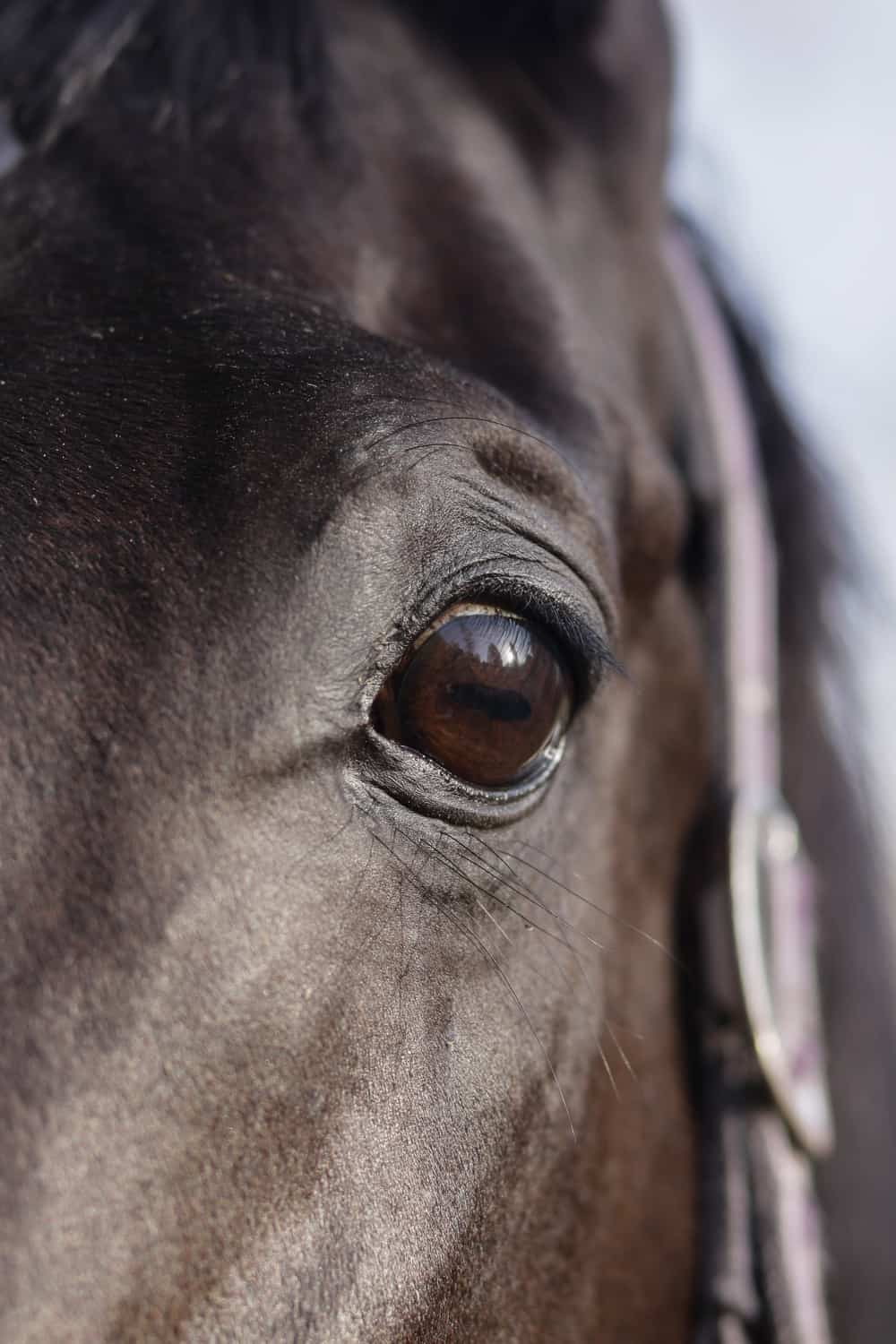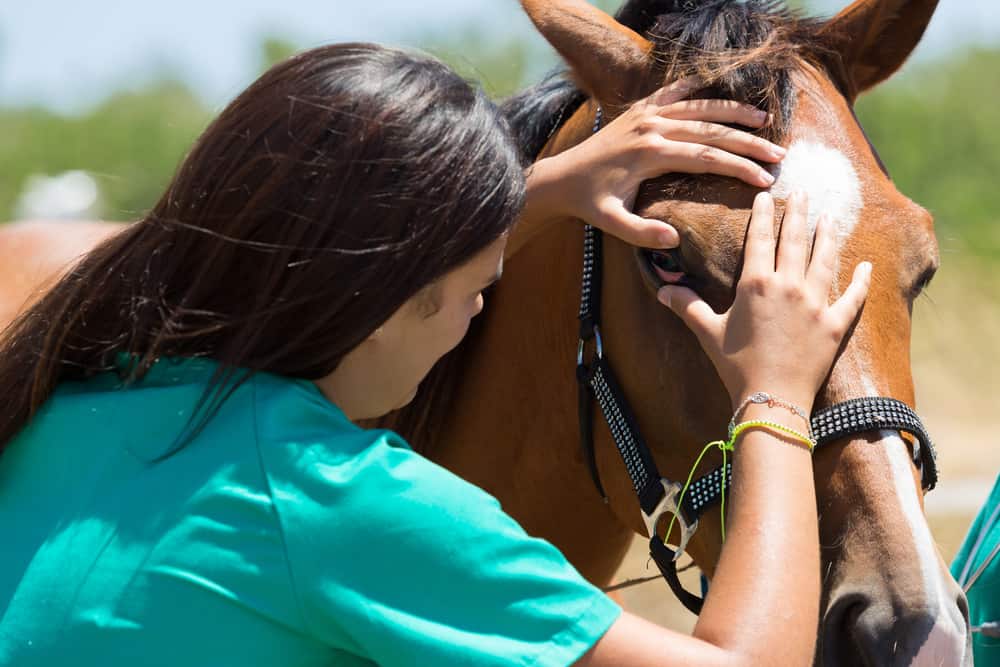With the largest-sized eyes in the land mammal kingdom and eight times larger than ours, horse vision is unique in many ways. Besides seeing in color and night conditions, their developed eyesight helps horses stay vigilant of predators lurking around.
Thanks to the 350° vision range, horses have a superb perception of the surroundings. Still, extrapolation can cause discomfort for equines due to blind spots and less depth perception.
Since equine vision differs from ours, having proper knowledge can help you ride and train them better. This guide outlines scientific facts about horse vision and other practical advice.
The Equine Eye
With eyes located laterally on both sides of the head, horses have an extensive vision field. Each eyeball has approximately 145° of single-eyed (monocular) vision. Moreover, since equine eyes are slightly to the front, they overlap for about 65° to 80° of binocular vision.
Pupil Shape
Thanks to the horizontal-oval pupils, horses can rotate their eyes in any direction and keep an eye on the horizon. The horizontal shape allows grazing animals to spot predators that might be approaching quietly.
Eye Color
Equine vision doesn’t depend on color. So far, there’s no solid evidence showing that light eyes are a decisive factor in sharp-sightedness. Most horses tend to have brown eyes, but you can also spot colors including green, blue, amber, haze, and yellow.
Eye Position
When approaching the fence in free jumping, any horse will adjust the head position. The animal may raise, lower, or tilt its head to work around the front blind spot. These movements help the horse get an exact idea of the obstacle ahead.
When the head is upwards, binocular vision gets activated as both eyes contemplate the upcoming jump. The vertical head position allows the horse to focus on the ground.
How Well Do Horses See?
Scientists believe horses have reasonable eye sharpness. In short, while human vision is about 20/20, horses’ acuity ranges from 20/30 to 20/60. Moreover, domestic horses tend to be nearsighted, whereas wild ones are more likely to be farsighted.
Yet, in dark conditions, horses have better eyesight than humans. The large-sized eyeballs let the maximum light available. Their retina can also adapt better and detect motion in low-light conditions.
Finally, since horses distinguish blue and green hues, they find it challenging to notice objects similar in color to the ground. Hence, most jumping obstacles are brightly-colored so that equines can easily spot them.
Fascinating Facts About Horse Vision
When speaking of animal eyesight, many believe animals see the world around the same way we do. However, this is an entirely wrong conclusion. Though we cannot know how horses perceive things exactly, scientists have reached several conclusions about the equine eye and its components.
1. Colored Vision
Though dissimilar to the human eye, horses can distinguish colors. In short, their vision is dichromatic, and they can tell between two color wavelengths within the visible light. As opposed, humans perceive color in three wavelengths (red, blue, and green). By combining them, we can see millions of colors.
The horse’s eye only gets the green and blue colors of the spectrum. Hence, these animals can differ between all blue and green color variations, but not red. To horses, red and similar colors appear green or yellowish. Equines find it easiest to perceive objects whose color contrasts with the background.
2. Can’t See Fine Details
The equine’s eye acuity is significantly worse than that of humans. So, they can’t perceive fine details while concentrating on items in the visual field centre. The typical sharp-sightedness in horses is nearly 20/30. Meaning, what we see clearly from 30 feet, equines will do at a distance of 20 feet only.
In a word, an average horse must come 50% closer to the object to discriminate what people can. Even in daylight, perceiving barrels, jumps, or weeds is flat, vague, and hazy. Still, horses have a more intricate perception than many other animals.
3. Superior Night Vision
Besides more rods, horses have a reflecting membrane which helps them see well in the dark. This thin membrane reflects and increases the light that enters the photoreceptors and gives horses enhanced vision in cloudy conditions. Plus, the structure of their eyeballs can pick up more light.
Horses can also do achromatic tasks in dim conditions more efficiently. Yet, equines take longer to adjust to abrupt changes in light levels. For example, your horse might not be coopering when it has to enter a dark barn or trailer from bright sunshine.
4. Vision Development Peak
How sharp a hose can see depends on the age and shape of the head. As your horse grows older, lenses lose flexibility. Scientists believe horses have the ideal sharp-sightedness at the age of seven. Equine eyesight gets fully developed once animals turn seven, and after that, their vision starts to deteriorate.
Horses with shorter concave noses, such as the Arabian breed, see worse than those with longer convex noses. For example, the eyesight of Thoroughbreds and Standardbreds is sharper, and hence they achieve better results in races.
5. Acuity Variations
As with people, individual equines have different acuity levels. One study demonstrated that 68% of the examined animals had perfect vision in both eyes. The rest were either nearsighted (couldn’t see clearly unless very close to the object) or farsighted (make out details only from a distance).
Variations in breed are also a common thing. For instance, Shires and Warmbloods tend to be farsighted, whereas Thoroughbred are more likely to be nearsighted. As a result, some breeds can excel in particular activities and respond to further visual stimuli better.
6. 350° Vision Range
Human eyesight ranges to approximately 45° on both sides of the nose. As opposed, horse vision is four times wider than ours. With eyes positioned on the sides, equines boast a 350° view that stretches from their nose tips to the straight back of their hips.
This wide range helps horses avoid predators and take flight when needed. However, equines can’t see directly in front of and behind them. As a result, they may be effectively blind for a short period while jumping over obstacles or narrow bridges.
7. Excellent Peripheral Vision
Thanks to their evolution, horses are well aware of any peripheral movement. The explanation for this lies in their large-sized retinas. Hence, they only need to make a subtle head turn to focus on objects. As opposed, humans take longer to process what size, color, and distance we perceive.
Since horses have monocular vision, they can see things with each eye. However, they also have binocular eyesight, which helps them focus on an object with both eyes. This way, equines can zero in on a selected point, such as trail obstacles we urge them to negotiate.
8. Two Blind Spots
Though horses can see an almost entire circle around them, they never know what’s behind. The second blind spot is right in front of their noses when the head and neck are straight. More specifically, these animals are blind from eye level to the ground below their face.
Unfortunately, your horse doesn’t see what he grazes, nor when you hold veggies to his mouth. Equines use their whiskers to sense what they eat. Finally, people working with horses should approach at an angle from the left and front, never from the rear, as a safety precaution.
9. Approaching Objects
Thanks to our forward-facing eyes, we see things in front of us without any effort. With horses, getting closer to things head-on is the wrong approach. Even worse, as they get nearer to the object, it will disappear in front of their eyes.
The best technique for horses to perceive barriers and items, in general, would be to approach them at an angle or loop closer. You may realize that pivoting or jumping sideways is a no-go strategy.
10. Lower Depth Perception
Despite the broad visual range, the side placement of the eyes deteriorates binocular vision to around 65° on the horizontal plane. This fair degree gives your horse a smaller field of depth perception. Hence, equines might find it challenging to determine relative distances.
Generally, horses tend to raise, tilt, or lower their heads to refine depth perception. Looser reins will allow your horse to move its head freely and judge distances better.
Bottom Line
Horse vision is extraordinary as they can differentiate colors, see in the dark, and at a 350° range. Having minimum knowledge of their vision can help us understand how they see the world.
The way horses react to changes in light and how they see close up and further away depends on the equine eye anatomy and abilities. Horses’ perspective is also vital when riding them out on trails and designing stables.
Did you find any of the facts outlined above surprising? Please, share your opinion with us in the comment box below and keep checking our site for more horse-related content.











all horse riders SHOULD be TAUGHT this. I’ ve been riding for over 60 years and found this article fascinating!